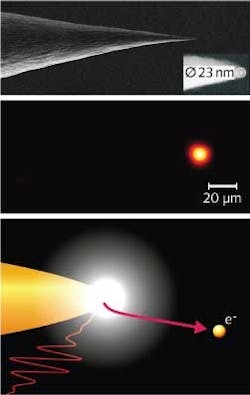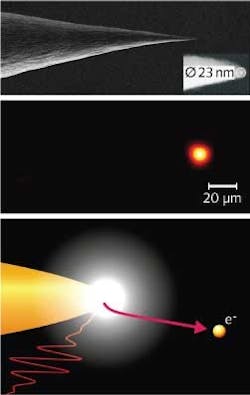In 1905, Albert Einstein used his “quantum” view of light to explain key attributes of the photoelectric effect: The energy of electrons emitted from a metal does not increase at higher light intensities, as the classical wave theory contends, but only the number of emitted electrons increases, consistent with light quanta. With the photon energy E = hν, each electron acquires energy from one photon, and only by increasing the light frequency ν (and not intensity) can the energy of the emitted electrons be increased.
Now, more than a century later, scientists at the University of Göttingen (Göttingen, Germany) have demonstrated that in the so-called strong-field regime—the interaction of extremely high-intensity laser light with atoms and surfaces—classical dynamics may indeed prevail in photoemission from metal nanostructures.1
“In the usual photoeffect, one electron absorbs one photon, but in our experiments, we found electrons that had hitched a classical ride on the light field itself to escape confinement on the nanoscale,” says University of Göttingen scientist George Herink. “Strong, few-cycle infrared light pulses focused on gold nanotips cause the energy of electrons to grow with increasing intensity and wavelength; some electrons acquire the energy of not just one photon, but more than a thousand photons.”
It is important to note that quantum mechanics is not violated in the experiments. The scientists found that classical motion dominates at high light intensities, while the quantum picture rules in the low-light regime. This is important to future strong-field physics experiments; it could lead to new ways of harnessing light and electron emissions on femtosecond and attosecond time scales.
Quenching the quiver motion
The photoelectric effect is governed by classical and quantum theory, with electron emission characterized by the Keldysh (adiabaticity) parameter γ. It relates the metal’s work function to the ponderomotive energy, which corresponds to the kinetic energy of an electron oscillating (“quivering”) in an intense laser field. In the strong-field regime (γ << 1), the electron energy no longer scales with that of the individual photon but with the ponderomotive energy, which goes up at high intensities and long wavelengths.
In the reported experiments, the electrons are driven out of the most intense region of the field (at the nanotip apex) within less than one optical half-cycle. Because this happens so rapidly, the quiver motion of the electrons is suppressed or quenched.
Focusing tunable femtosecond pulses with wavelengths up to 8 μm onto electrochemically etched gold tips with a radius of curvature of ~10 nm in an ultrahigh-vacuum environment, the scientists explored the kinetic-energy spectra of photoelectrons in the strong-field regime with Keldysh parameters as low as ~0.1 (see figure). They found that at the apex of the nanotips, photoelectron emission was observed at kinetic energies up to hundreds of electron volts, scaling with the input laser intensity and wavelength—indicating “classical” dynamics but with a signature modification from the nanostructures.
“Studying the strong-field regime in atomic and molecular systems has already produced exciting results over the past decade,” says professor Claus Ropers, leader of the study. “Nanostructures now offer us a completely new arena within which to study, manipulate, and control strong-field effects. The type of ‘neoclassical’ dynamics we’ve found nicely illustrate these new frontiers.”
“Based on our findings, we’re presently creating new tools that steer electrons on nanoscopic racetracks,” adds senior scientist Daniel Solli.
REFERENCE
1. G. Herink et al., Nature, 483, 7388, 190–193 (March 8, 2012).

